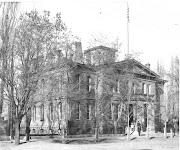When does a really rare coin
that is also a problem coin
cease to be desirable?
With all the hoopla surrounding the registry set craze and certified coins in general, the hobby normally discounts coins with problems. Currently there are no set standards to the price deductions of coins based on the degree of the problem. Coins that don't make it into one holder as a problem coin, may make it into another holder as a good coin. The problem may be "barely detectable" as with a light old cleaning, to quite bad as would be the case for a coin that was holed or damaged.
If the coin is an 1884 CC Morgan dollar with a problem, it's easy to pass, because a nicer coin can be found immediately at nearly every dealer's shop, show or auction house. But, if the coin happens to be a desirable rarity such as an 1870 cc quarter or 1873 cc dollar that's cleaned, how would you value it? Or, would you just pass knowing that these coins rarely surface. Please comment.

1873-CC With Arrows dime with porous surfaces on obverse.






2 comments:
Great question. For myself, if I'm looking at a CC coin with 200 to 300 or less survivors, I will take a long look at one that has been lightly dipped or lightly cleaned. If the coin has terribly noticeable rim dings, large unsightly scratches, graffitti, I will let it pass regardless. Same for a coin that has been used as jewelry (holes etc.) Also, coins that show signs of tooling or that are bent, I will let those pass too, regardless. The vast majority of CC gold coins you find on the market today have undergone some form of dipping and or cleaning in the past; there's no escaping that fact. Only those with Forbes 400 type bank accounts could build sets of "untouched" CC gold (in particular) and then, only if and when available. I have seen many lightly dipped/cleaned coins that are nice looking, solidly graded coins. Beauty is in the eye of the beholder.
A second comment. In fairness, I made my first comment before your 1873-CC with arrows dime was shown. Of course we all would love to have the finest specimens possible, but a rare date like this one...I see nothing wrong with having that coin in a collection. It is possible that the porosity came from the dies and has been with that coin from the moment it was struck. Your coin pictured is better than most of that date you will ever see.
Post a Comment